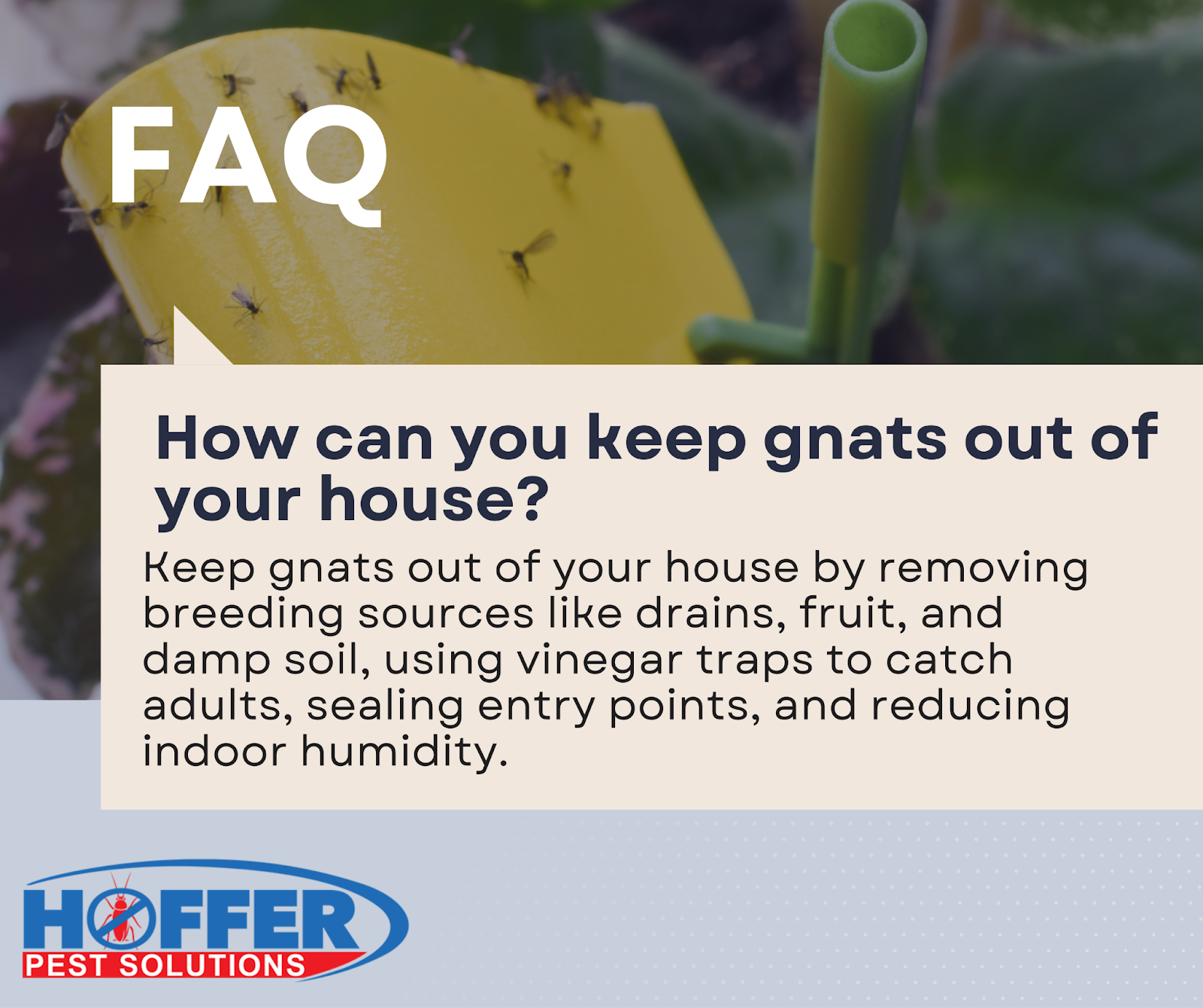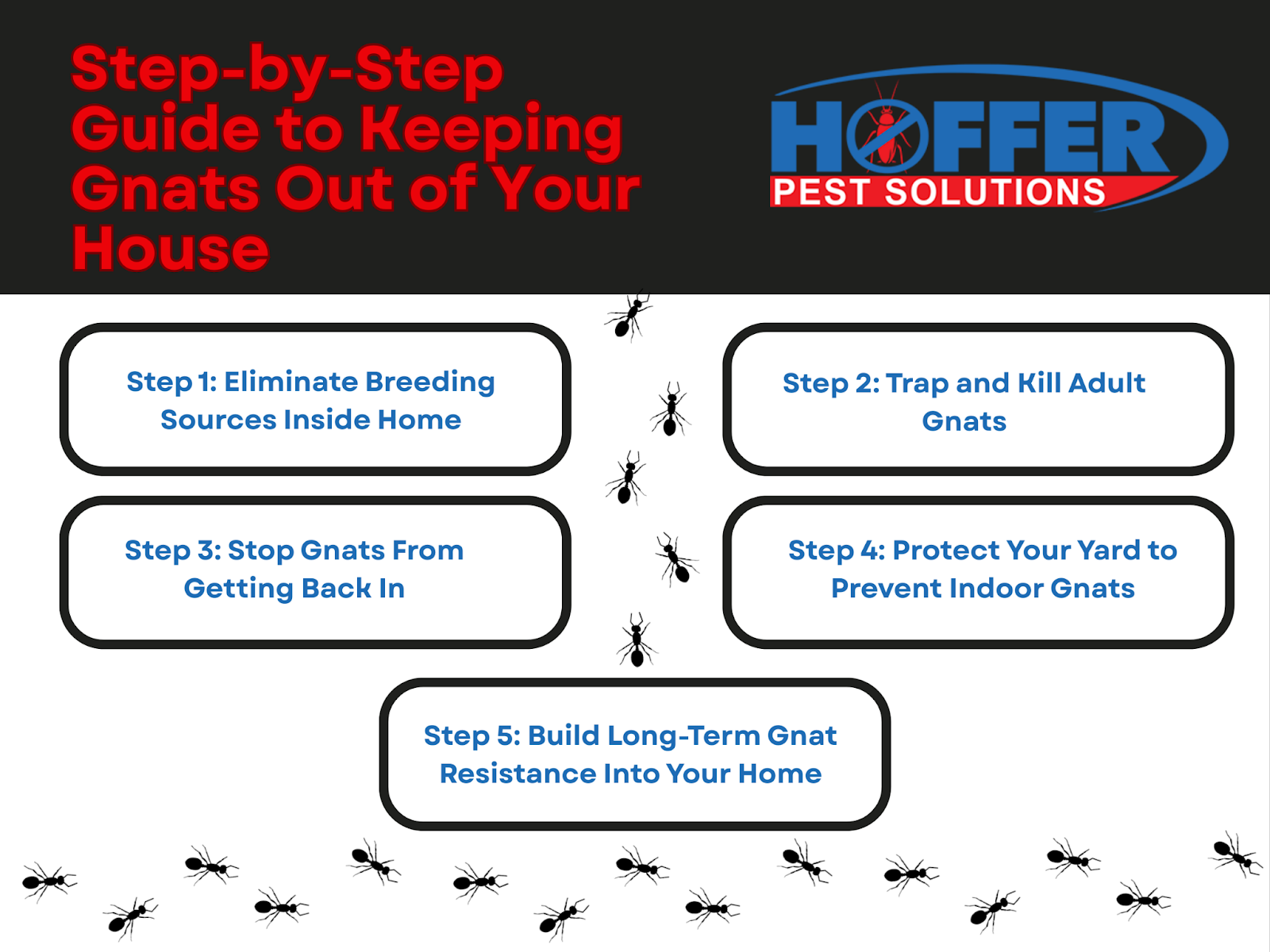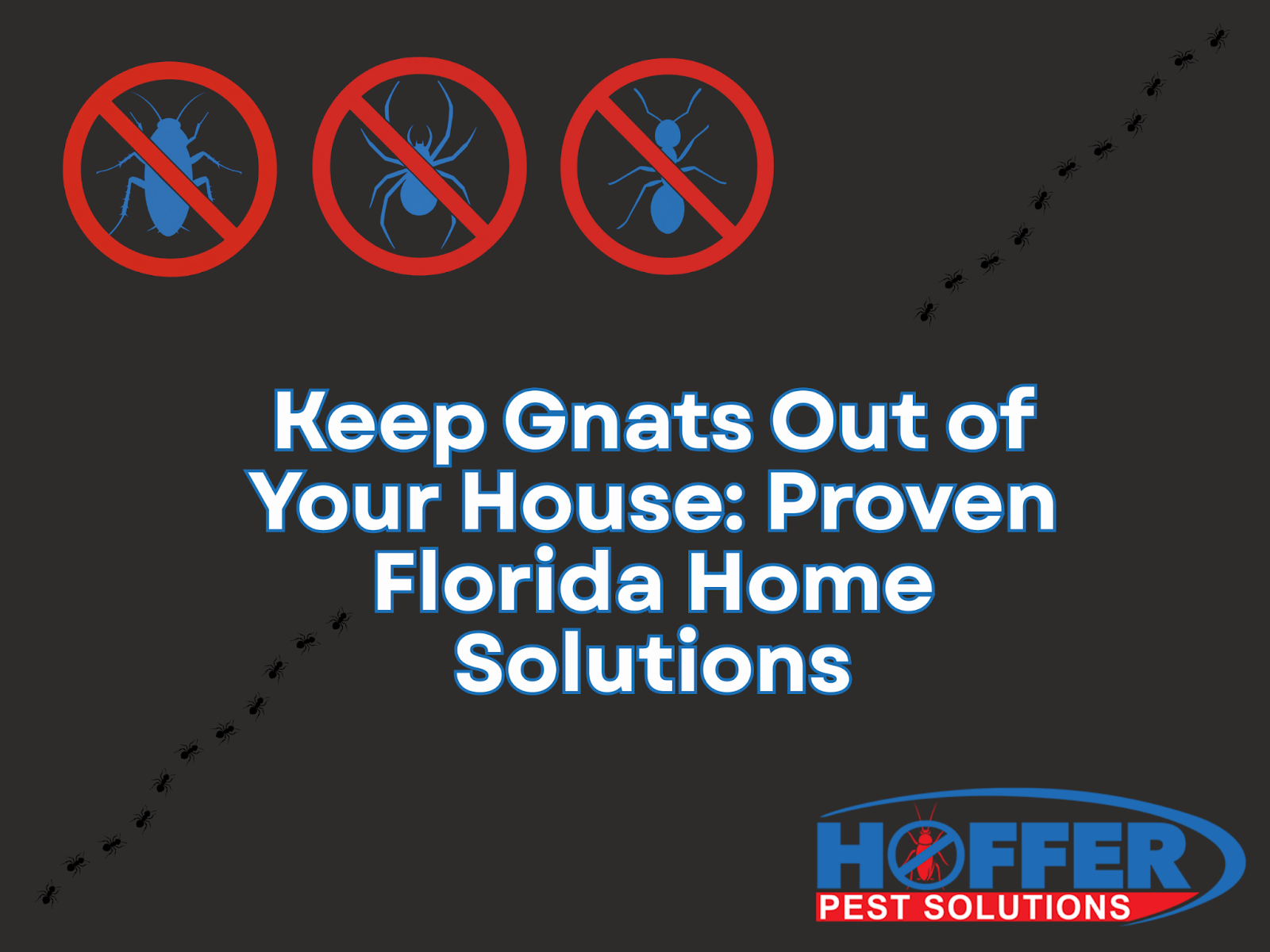Keep gnats out of your house by removing breeding sources like drains, fruit, and damp soil, using vinegar traps to catch adults, sealing entry points, and reducing indoor humidity.

Gnats multiply quickly, spread bacteria, and thrive in Florida’s year-round humidity. The good news is you can stop them by targeting their breeding spots, using proven traps, and making simple home adjustments that cut off their lifeline.
In this guide, you’ll learn why gnats invade Florida homes, how to eliminate them at the source, the best traps and long-term prevention tips, and when it’s time to call in professional help.
If you’d rather not deal with recurring infestations, Hoffer Pest Solutions provides fast, same-day service backed by decades of experience keeping South Florida homes pest-free.
Below, we’ll walk step by step through everything you need to know to keep gnats out of your house for good.
Step-by-Step Guide to Keeping Gnats Out of Your House

Gnats can feel unstoppable once they show up, but the solution is simple when you break it into clear steps. By following each stage in order, identify, eliminate, trap, prevent, and monitor, you’ll tackle the root of the problem and keep your Florida home comfortable year-round.
Step 1: Eliminate Breeding Sources Inside Home
The fastest way to get rid of gnats is to cut them off at the source. Gnats can’t multiply without moisture and organic matter, so removing those conditions breaks the cycle.
Fruit: Keep produce in the refrigerator, throw away anything overripe, and use sealed trash cans so odors don’t attract flies.
Drains: Gnats thrive in the slimy film inside pipes. Flush with boiling water, follow up with enzymatic cleaners (safer and more effective than bleach), and use the “tape test”, cover the drain overnight with clear tape. If gnats stick to it by morning, you’ve found an active breeding site.
Plants: Fungus gnats love damp soil. Let soil dry between waterings, use a gravel top layer to block them from emerging, or test with raw potato slices that lure larvae away from roots.
Appliances: Don’t forget hidden spots like refrigerator drip pans, damp rags, and sponges. These often-overlooked sources can sustain infestations.
If you don’t keep houseplants or fruit yet still see gnats, chances are they’re coming from drains, plumbing leaks, or moisture in walls and window trim.
Step 2: Trap and Kill Adult Gnats
Even when you’ve removed the source, a few adults may still be flying around. Trapping them helps knock down the population while your prevention measures take effect.
DIY Traps That Work
Vinegar Trap: Mix apple cider vinegar with a few drops of dish soap. The scent attracts gnats, while the soap breaks surface tension so they sink and drown.
Wine Substitution: Red wine works just as well if you don’t have vinegar on hand.
Fruit Jar Trap: Place a piece of overripe fruit in a jar, cover with plastic wrap, and poke small holes. Flies crawl in but rarely find their way out.
Candle-in-Water Trap: At night, light a candle in a dish of water. Gnats drawn to the flame often fall and drown.
Beyond DIY
Sticky Yellow Cards: Place near houseplants or fruit bowls to monitor hotspots.
Plug-in Light Traps: These attract and capture gnats quietly.
Beneficial Nematodes: For fungus gnats in soil, microscopic nematodes (Steinernema feltiae) attack larvae. They’re safe for plants and pets and can succeed where sprays fail.
Carnivorous Plants: Cape sundews and similar species can act as natural “gnat traps” in plant-heavy homes.
Many homeowners ask whether DIY sprays are safe around kids or pets. While some are marketed as safe, it’s best to rely on source control and passive traps before introducing chemicals.
Step 3: Stop Gnats From Getting Back In
Once you’ve cleared an infestation, prevention is key.
Exclusion: Keep window and door screens intact, seal gaps around trim, and reduce light leaks at glass doors. Gnats are strongly attracted to light at night, which is why you often see swarms by sliding doors. Adding a bug zapper near entry points can intercept them before they slip inside.
Humidity Control: Wipe sinks dry, run dehumidifiers in damp rooms, and keep air circulating to reduce the moisture gnats depend on.
Seasonal Habits: Expect populations to spike during rainy or humid months. Starting preventive measures early in the season helps stop infestations before they explode.
Step 4: Protect Your Yard to Prevent Indoor Gnats
Most indoor infestations start outside. By keeping outdoor breeding areas under control, you cut down on the gnats that try to get indoors.
Check yard drains and gutters: Standing water is a gnat magnet. Keep gutters flowing and outdoor drains clear of debris.
Watch mulch and compost: Overwatered mulch beds and compost piles can fuel fungus gnat and fruit fly populations. Turn compost often and avoid piling mulch against your home.
Maintain lawn moisture: Irrigation systems that overwater create ideal breeding sites. Adjust watering schedules to keep the yard healthy but not soggy.
Outdoor lighting: Switch porch bulbs to yellow “bug lights” that attract fewer gnats at night.
This step reinforces that protecting your perimeter makes indoor prevention easier.
Step 5: Build Long-Term Gnat Resistance Into Your Home
Gnats are opportunists. Instead of waiting for the next swarm, homeowners can build pest resistance into their routines.
Quarterly maintenance: Flush drains regularly, check drip pans, and inspect window seals.
Houseplant care calendar: Rotate soil checks, replace old potting mix, and use sticky cards as monitoring tools.
Proactive monitoring: Use the tape test every few months to catch drain fly problems before they explode.
Seasonal readiness: Before Florida’s rainy season, prep by lowering indoor humidity, inspecting irrigation systems, and sealing any new gaps around doors or windows.
By making these steps part of your routine, you create an environment where gnats can’t get a foothold, year after year.
Why Are There Gnats in My House?
Living in South Florida means year-round pest pressure. Unlike colder regions, where winter naturally knocks insect populations down, our humidity and heat create the perfect environment for gnats to thrive any month of the year.
Not all “gnats” are the same. Fruit flies breed on overripe produce and trash. Drain flies thrive in the slimy buildup inside pipes. Fungus gnats often emerge from damp potting soil. Phorid flies, sometimes mistaken for gnats, can be a sign of plumbing issues beneath your home. And in some cases, people misidentify springtails, tiny jumping insects that aren’t gnats at all.
Local homeowners also face unique risks: rotting window trim, standing water in A/C drip pans, and hidden plumbing leaks are all common breeding grounds. Identifying the type of pest is the first step to solving the problem.
Hidden Problems Most Guides Don’t Cover
Sometimes gnats persist even after you’ve done everything right. That’s usually a sign of a deeper issue.
Sewer Leaks: Phorid flies, which many mistake for gnats, can breed in cracked pipes under a slab. Solving this may require a plumber with a camera to locate the leak before repairs are made.
Structural Issues: If gnats consistently appear near windows, rotting wood or failed caulking could be harboring moisture inside walls.
Misdiagnosis: Homeowners often waste time on gnat traps when the culprit is springtails, which jump rather than fly. Identifying them correctly saves frustration.
Outdoor Surges: Neighborhood-wide swarms often come from standing water or drainage issues. In those cases, local vector control may step in to help.
If you’re worried about the possibility of a costly sewer repair, remember, diagnosis comes first. Not every infestation means breaking concrete. A professional inspection can rule out problems before you invest in unnecessary fixes. Need Help? Contact us and claim your free inspection.
When DIY Isn’t Enough: Professional Help in South Florida
Most gnat infestations can be resolved with a combination of sanitation, traps, and moisture control. But if you’ve tried everything and still see swarms, it often points to hidden sources, like leaks under the slab, wall void moisture, or breeding sites you can’t reach.
That’s where professional help makes the difference. A thorough inspection follows a proven process:
Identify the species (so you’re not fighting the wrong pest).
Remove the breeding source through cleaning or repair.
Prevent by sealing entry points and addressing moisture issues.
Follow up with traps, monitoring, and adjustments as needed.
Why Hoffer Pest Solutions Is The Correct Choice
Hoffer Pest Solutions has spent over 40 years protecting homes in South Florida. Our family-owned business understands the unique pest challenges here, year-round humidity, structural moisture, and seasonal surges. We offer:
Same-day service if you call before noon.
Year-round protection plans (Home Shield Classic, Advantage, and Complete) to stop problems before they start.
A local team that treats you like neighbors, not just account numbers.
Some homeowners worry, “What if the gnats just come back?” That’s exactly why ongoing follow-up matters. We stand behind our work with service guarantees and proactive solutions, so you don’t have to face the same problem twice.
Take Back Your Home Today
Gnats don’t have to be a permanent part of life in Florida. By addressing breeding sources, using proven prevention strategies, and getting professional support when needed, you can keep your home comfortable and pest-free.
Our mission is simple: deliver peace of mind through world-class service. If gnats are taking over your home, we can help you reclaim your space quickly and safely. Schedule a same-day inspection with our team today, and let us protect your family, your comfort, and your most valuable investment, your home.
Frequently Asked Questions (FAQ)
Are gnats seasonal in Florida?
No. While northern states get a winter break, Florida’s warm and humid climate allows gnats to breed year-round. You may notice bigger spikes after rainy weather, but without proactive prevention, they can be a constant nuisance.
Do nematodes really work for houseplants?
Yes. Beneficial nematodes (Steinernema feltiae) are highly effective against fungus gnat larvae. They’re safe for plants, people, and pets and often provide longer-lasting control compared to sprays or dunks.
Will vinegar traps alone solve the problem?
No. Vinegar and fruit traps catch adult gnats, but they don’t touch eggs and larvae. Unless you remove the breeding source, gnats will keep coming back.
Can gnats harm my health?
Fruit flies and drain flies are more annoying than dangerous, but they can spread bacteria after contact with drains and decaying matter. Phorid flies are even more concerning, since they sometimes indicate sewer issues.


